Charting a more efficient medical education
by Tracy Kalytiak |
What do you imagine when you hear the words "medical school?" Many might think of massive biochemistry and anatomy textbooks, and professors administering PowerPoint sedatives to auditoriums full of students.

Dr. Robert Furilla, Dr. Cindy Knall and Dr. Jane Shelby presented Alaska WWAMI's successful curriculum proposal in Seattle earlier this year. Photo courtesy Robert Furilla
Those images are about to change: Students in WWAMI's 2015 entering class will be freed to spend drastically less time in classrooms and more time helping patients, solving health care problems as a team and learning clinical skills from physicians.
A sweeping curriculum change devised by an Alaska committee of health care educators is making this shift possible. And, Alaskans participating in WWAMI will have the option of staying here while completing their 87-week foundations phase.
"This is the biggest curriculum change in WWAMI's 42-year history," said Dr. Jane Shelby, academic director of Alaska WWAMI. "It's a very dynamic situation. People have looked at what are we teaching medical students that prepares them to practice in today's environment of health care delivery. Our two main focuses were, what would be the best way to have a curriculum integrating basic and clinical science and what would be the best way to deliver that curriculum-what would be best for the student and the program."
Why change?
WWAMI students receive their medical education through the University of Washington School of Medicine.
The catalyst for transforming WWAMI's curriculum has occurred following more than 10 years of changes across U.S. medical schools, pushed in part by the Liaison Committee for Medical Education, the accreditation body for U.S. medical schools, mandating a shift away from the archaic practice of forcing U.S. medical students to sit through lectures and toward helping students access medical knowledge and experiences in more modern, efficient ways.
Dr. Robert Furilla, Alaska WWAMI's associate director, said the goal was to reduce the number of hours instructors spend lecturing to students-keeping that time to one hour a day, maximum-and try to keep together like subjects.
"When you're dealing with the heart, you deal with the physiology, with the pathology, with the pharmacology all at one time," Furilla said. "This is different from the traditional system in which you had a physiology course, followed by a pathology course, followed by a pharmacology course. We wanted to break them into smaller pieces and deal with them completely so the student gets a good idea of what's going on with the heart-from how it works, to what goes wrong to how do you fix it-all in a continuous discussion before moving on to something else."
More than 70 percent of U.S. medical schools created team-based and active-learning methods of educating students. Schools that ignore the LCME's mandate face the threat of probation or loss of accreditation.
UW, in December, requested proposals to integrate the structure of the scientific-foundations phase of the curriculum. An Alaska WWAMI multidisciplinary committee convened in late December for a brainstorming session and submitted one of the 38 proposals UW received. Members of the Alaska WWAMI committee included Dr. Shelby, Dr. Furilla, Dr. Cindy Knall, Dr. Tim Hinterberger, Dr. Megan Ritter, Dr. Meredith Lann, Jamie Elswick, Dr. Quentin Reuer and Dr. Tanya Leinicke.
"We met, we discussed, we filled up a huge whiteboard in the next room with our ideas and we started to fill in blocks based on everybody's expertise where we thought things should go," Shelby said.
UW officials winnowed out 25 of the proposals and chose Alaska's as one of 13 that would be presented in a forum in Seattle at the end of January.
"There was a lot of open process for everyone within WWAMI and the School of Medicine to look at the different proposals and give feedback," Shelby said. "[Later, in Seattle,] I was asked to leave the room so they could discuss our proposal. I was out for a long time, waiting and waiting. I did not think we'd come back overwhelmingly on top. When I was invited back into the room, that was what they announced, that this is the format they wanted to go with. So that's how it unfolded. We're proud of this."

Dr. Jane Shelby, Alaska WWAMI's academic director, was a member of a committee that created the winning proposal for a new curriculum structure for the University of Washington School of Medicine's WWAMI region schools. Photo by Philip Hall/University of Alaska Anchorage
Building blocks of education
Instead of four years of medical school, the new WWAMI curriculum will offer three phases: a foundations phase, patient-care phase and an explore-and-focus phase.
Members of WWAMI's 2015 entering class will begin their foundations phase of medical school July 27, 2015, launching into four weeks of clinical immersion followed by blocks of content integrated with clinical experience. Blocks offer the following topics:
• Molecular and cellular basis of disease
• Anatomy
• Immune system
• Circulatory systems
• Blood and cancer
• Metabolism, nutrition and endocrinology
• Brain and behavior
• Life cycle and reproduction
"For the circulatory system, I would hope for the first day of class the students will be introduced to a couple of heart patients and hear the experiences of those patients who have heart disease," Furilla said. "The patients-and their case history and medical details- will be presented by a physician who will talk to the students about this patient's heart. And so as they learn about the biochemistry and the physiology and the abnormal pathology of heart disease, they'll be thinking about the patients they met the first day of class. That's what we mean about enhancing the students' experience and bringing more relevance to their experience."
Shelby says the curriculum offers more efficiency to students.
"That's where adult learning comes in," she said. "Rather than having pieces and parts over two years, they'll have this continuum of a story about the heart or the complete story about the brain and lots of aspects that are comprehensive. We'll teach anatomy with imaging so the students not only learn through cadaveric dissection but they're also comfortable learning reading MRIs and CT scans and X-rays by the end of the foundations phase."
Students serve clerkships throughout each block of study, and two-week "intersessions" between blocks allow them to plan scholarly projects and study for board exams.
The students transition out of foundations phase in January 2017 and begin patient phase clerkships in March 2017, delving into medicine, surgery, neurology, family medicine, pediatrics, obstetrics and psychology. Their "explore and focus" phase begins April 2, 2018, and students transition to residencies a year later, in 2019.
Shelby says students will do part of their clinical training in Seattle, during a 12-week block sometime in their third year. "It's a good thing they go to Seattle, to the big city, to the big medical centers," she said. "That's a very important opportunity for students."
The big picture
Shelby says the new curriculum helps students develop skills for lifelong learning by encouraging them to take material from a book, the web, video offerings WWAMI makes available and other resources. They learn to integrate the material and come to class prepared. "They don't need to be spoon-fed the material," she said. "They don't need a lecture. So class can be taking what they've learned and solving a problem with another team of students and taking it to the next level of learning-critical thinking and application of knowledge. Students often do much better because we're getting out of their way and letting them learn."
Alaska WWAMI student Tom Steck sees the benefits of using lectures combined with team-based learning when teaching medical students.
"Professors are professors for a reason," he said. "They've spent years studying this material. I think just having the material explained to you by a professor still has a lot of value. For me, personally, I think I learn quite a bit from lectures. But everyone learns a little bit differently. There's so much value to having that peer accountability you get with team-based learning and, frankly, just to do something other than take notes is certainly welcome. Both have their place. It's just finding which classes are best suited for TBL and which are best suited for lecture and going forward."
Written by Tracy Kalytiak, UAA Office of University Advancement
 "Charting a more efficient medical education" is licensed under a Creative Commons Attribution-NonCommercial 4.0 International License.
"Charting a more efficient medical education" is licensed under a Creative Commons Attribution-NonCommercial 4.0 International License.














